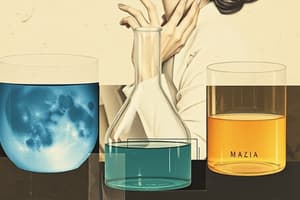Podcast
Questions and Answers
Describe solids, liquids and gases in terms of shape and volume.
Describe solids, liquids and gases in terms of shape and volume.
Solids have a definite shape and volume. Liquids can change shape but NOT volume. Gases change both shape and volume.
What is a gas?
What is a gas?
The state in which matter changes in both shape and volume. A gas takes the shape and volume of its container.
What is a liquid?
What is a liquid?
The state in which matter takes the shape of its container and has a definite volume.
What is pressure?
What is pressure?
What is a solid?
What is a solid?
What are the states of matter?
What are the states of matter?
What are the two types of solids?
What are the two types of solids?
What are crystalline solids?
What are crystalline solids?
What are amorphous solids?
What are amorphous solids?
What are the two important properties of liquids?
What are the two important properties of liquids?
What is surface tension?
What is surface tension?
What is viscosity?
What is viscosity?
Can the volume of gas change?
Can the volume of gas change?
What are the two conditions that affect gas?
What are the two conditions that affect gas?
What is temperature?
What is temperature?
What is another name for liquids?
What is another name for liquids?
What solid melts at a distinct temperature?
What solid melts at a distinct temperature?
What solid does not melt at a distinct temperature?
What solid does not melt at a distinct temperature?
Are liquids and gas both considered 'fluids'?
Are liquids and gas both considered 'fluids'?
Flashcards are hidden until you start studying
Study Notes
States of Matter Overview
- Matter exists in three primary states: solid, liquid, and gas, each defined by unique shape and volume characteristics.
- Solids maintain a definite shape and volume, while liquids take the shape of their container but have a fixed volume, and gases adapt to both the shape and volume of their container.
Solid State Characteristics
- Solids are divided into two categories: crystalline and amorphous.
- Crystalline solids have an orderly, three-dimensional atomic arrangement, resulting in a repeating pattern; examples include iron, diamonds, and ice.
- Amorphous solids lack a defined structure or pattern, with particles positioned at random; examples include rubber and wax.
Liquid State Properties
- Liquids possess two significant properties: surface tension and viscosity.
- Surface tension is the force at the liquid's surface that enables it to form spherical shapes; it varies among liquids, with mercury having a higher surface tension than water.
- Viscosity measures a liquid's resistance to flow; for instance, honey flows more slowly than water due to its higher viscosity.
Gas State Characteristics
- Gases can change both shape and volume, with particles spread apart to fill available space, lacking a definite shape and volume.
- The primary factors influencing gas behavior are pressure and temperature.
- Temperature is a measure of the average energy of particle motion; higher particle movement correlates with increased temperature.
General Definitions and Terms
- The term "fluids" collectively refers to both liquids and gases, as they can flow unlike solids.
- Crystalline solids melt at a distinct temperature, while amorphous solids do not possess a specific melting point.
Studying That Suits You
Use AI to generate personalized quizzes and flashcards to suit your learning preferences.




